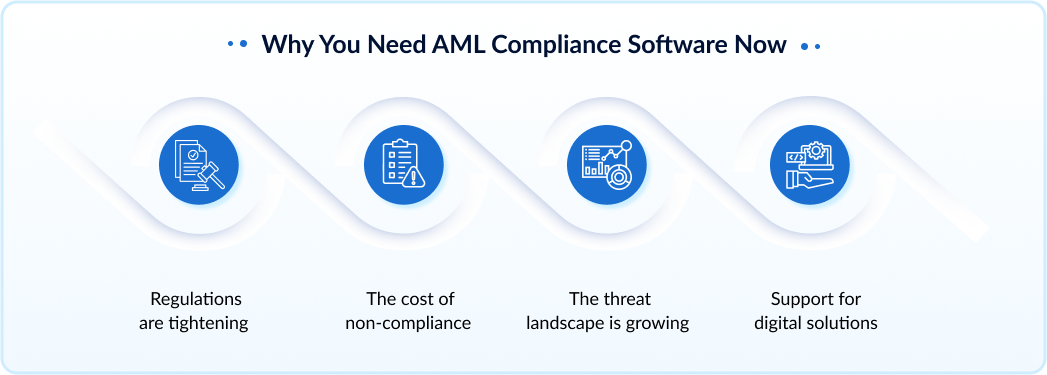Keeping up with compliance in today’s fast-paced financial world is no small feat. Financial crimes are on the rise, and regulatory pressures are increasing across the globe. If you’re feeling the squeeze with mounting compliance requirements or struggling with outdated manual processes, you’re not alone.
According to Nasdaq, in 2023, an estimated $3.1 trillion in illicit funds flowed through the global financial system. That same year, fraud scams and bank fraud schemes totaled $485.6 billion in projected losses globally. On top of that, fraud scams and bank fraud schemes were projected to cause a whopping $485.6 billion in global losses.
Here’s the good news – Anti-Money Laundering (AML) compliance software is here to help.
This guide is your one-stop resource if you’re in sectors like banking, fintech, insurance, crypto, or any enterprise dealing with money. We’ll walk you through what AML compliance software does, the must-have features, how to choose the right solution for your business, and even explore the ROI. By the end, you’ll feel more confident navigating today’s complex compliance landscape.
Let’s get started!
What Is AML Compliance Software?
Put simply, AML compliance software is a tool designed to help businesses stay on the right side of the law. It automates processes like monitoring suspicious transactions, verifying customer identities, and flagging activities that could indicate fraud or money laundering.
Why does it matter so much in 2025? Well, regulatory fines are stricter, financial crimes are smarter, and staying compliant without advanced technology is nearly impossible. Manual compliance processes are prone to errors, delays, and hefty penalties – not to mention, they take up far too much time.
That’s where AML software comes in, acting as your compliance team’s smartest tool.
Whether you’re a bank monitoring countless daily transactions or a fintech startup navigating complex onboarding regulations, AML compliance software takes the heavy lifting off your plate.
And in this guide, you’ll learn exactly what it does, its must-have features, and how to find the best option for your specific needs.
What Does AML Compliance Software Do?
Wondering how it all works?
Here’s a quick breakdown of what anti-money laundering tools bring to the table:
Transaction Monitoring System
This feature tracks your financial transactions in real-time, analyzing patterns and red flags. For instance, if someone suddenly starts making large international wire transfers, the software will sound the alarm. This makes it easier to spot suspicious activity as it happens.
KYC Automation and Onboarding
KYC, or “know your customer,” is the process of verifying customer identities. AML software automates this process, allowing you to confirm customer information quickly and correctly. For example, instead of manually reviewing ID documents for every new user, automated KYC tools do it in seconds while reducing human error.
Compliance Automation
Every regulatory framework has checklists you must complete. Compliance automation ensures these are ticked off effortlessly, saving your team hours and avoiding costly mistakes.
Suspicious Activity Reporting (SAR)
When something looks fishy, reporting it is key. AML software out there includes modules for filing standardized SARs with the right authorities, so you stay compliant.
Customer Identity Verification
Fraud often starts with fake identities. AML tools work as a customer identity verification solution, reducing risks tied to false documentation or synthetic identities.
Real-Time Risk Management
Staying on top of risk means acting fast. With AML software, businesses get real-time updates and actionable insights into potential compliance issues, keeping things under control.
Think of these features as your first line of defense against both financial crime and potential fines.

Why You Need AML Compliance Software Now
Still debating whether you need it?
Here’s why this isn’t something to put off:
Regulations Are Tightening
Governments worldwide are stepping up their rules around money laundering and financial crime. If your processes don’t meet standards, fines can cost millions.
The Cost of Non-Compliance
Beyond fines, non-compliance can damage your reputation permanently. AML software safeguards both your bottom line and your brand.
The Threat Landscape Is Growing
Cybercrimes, money laundering, and fraud are more sophisticated than ever. Without intelligent software, staying ahead of threats is next to impossible.
Support for Digital Solutions
Advanced AML platforms integrate with vendors for document verification, identity proofing, and more. This flexibility streamlines processes and enhances security.
The bottom line? Delaying investment in AML software could cost you far more in the long run.
Key Features to Look for in AML Compliance Software
When choosing your compliance software, not all features hold equal weight.
Here are the game-changers to seek out:
Transaction Monitoring System
Why it’s critical: It spots unusual activity automatically. For example, a bank could identify a customer by structuring transactions to avoid reportable thresholds.
KYC Automation
Manual KYC is both time-consuming and error-prone. Automation simplifies verification, even during high-volume onboarding periods.
Real-Time Risk Scoring
This feature assigns risk levels dynamically, helping you prioritize threats that need urgent action.
AI-Powered Suspicious Activity Detection
AI improves accuracy by detecting patterns humans might miss – like subtle links between seemingly unrelated transactions.
AML Compliance Checklist Builder
Staying organized is half the battle. A built-in compliance checklist ensures you’re audit-ready at all times.
Digital Document Verification
Scan IDs, passports, and more without manual intervention. Think faster approvals and fewer errors.

Compliance Audit Tools
Prepare for audits easily with customizable reporting options. No more scrambling through spreadsheets!
Identity Proofing Integration
If you rely on third-party vendors for fraud checks, the right software integrates seamlessly, saving time and effort.
Regulatory Report Generation
Meet different region-specific standards effortlessly. Whether it’s for the US, UK, or EU markets, automated reporting simplifies compliance.
Each of these features can address common pain points like inefficiency, fraud detection errors, or cumbersome reporting processes.
How to Choose the Right AML Compliance Software for Your Business
Picking the right solution might feel overwhelming, but here’s a roadmap to guide your decision:
Assess Your Risk Level
High-risk industries like crypto will need advanced tools compared to low-risk sectors.
Identify Your Industry’s Needs
The software that works for a bank might not work for fintech. Look for industry-specific solutions.
Understand Your Compliance Regions
Make sure the software supports all regulatory requirements in your region, whether that’s the US, Europe, or beyond.
Check for Must-Have Integrations
Your Customer Relationship Management (CRM) software, Enterprise Resource Planning (ERP), or other tools should easily connect with the AML solution.
Consider Your Team
If you lack an in-house compliance team, prioritize software with user-friendly tools and support.
AML Buyer Checklist
Finding the right AML compliance software doesn’t have to be complicated.
This simple, actionable checklist will help you make the best choice for your business:
- Does it offer the features we need?
- Can it integrate with our existing tools?
- Is it adaptable to our industry and region?
- Does it match our risk profile?
Protect your organization from compliance headaches by choosing a solution that aligns with your unique business needs.
Pricing Models & ROI of AML Software
Investing in compliance software might seem costly upfront, but the return can outweigh the expense.
Subscription vs. License Pricing
Most vendors now offer subscription-based models, making costs predictable and scalable as your business grows.
Typical Pricing Tiers
Smaller businesses may spend a few thousand annually, while large enterprises could see higher tiers with advanced features.
Return on Investment
Think of hours saved through automation, fewer penalties, and reduced risk exposure. For example, replacing manual transaction reviews can save teams weeks of work annually.
The Bottom Line
AML compliance software isn’t just a tool; it’s peace of mind. It protects your business from regulatory fines, ensures efficient operations, and helps detect risks before they escalate.
Whether you’re navigating the complexities of crypto, running a fintech startup, or managing a major bank, the right software equips you to stay compliant and ahead of the competition.
Take the complexity out of compliance with FTx Identity!
Schedule your consultation today and see a personalized demo built around your unique needs!
